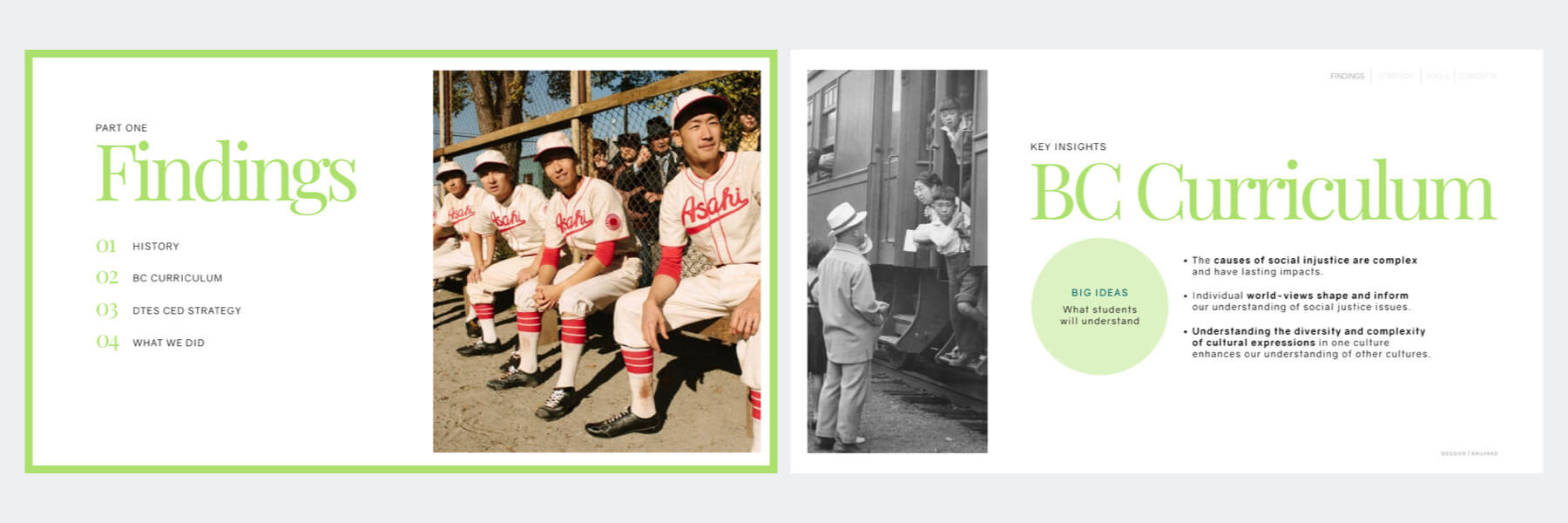The Japanese Hall, strategy for a historic interpretive space
At Dossier Creative, I strategized and developed a framework for The Japanese Hall and Language School's future historical interpretive center.
A heritage building established in 1906, The Japanese Hall and Language School is a non-profit, driven organization with a strong commitment to education, culture, and community. This was a client project I worked on at Railyard Lab for the brand and innovation firm, Dossier Creative.
Roles
- Research & strategy
- Designer, Railyard Lab
Duration
June to August 2019
Tools
Keynote, Adobe Creative Suite
Opportunity
Envisioning an interpretive experience in the Japanese Hall and Language School that elevates the prominent themes of the Japanese-Canadian story while also taking into consideration the BC School Curriculum and the existing community of the Downtown Eastside.
Deliverables
Compiled within a comprehensive deck to hand over to the Japanese Hall and Language School, we've developed a framework for inspiring and evaluating future creative concepts using spatial, technological, and storytelling tools.
Our findings were presented to Vancouver Senior City Planners, Nikkei National Museum and Cultural Centre, and The Japanese Hall and Language School's architect partners. The final project became the foundation for the Historic District application for Japantown.

Findings
A series of workshops, interviews, and community immersion activitives informed our findings.
Some highlights of our research included:
A historic walking tour led by Laura Saimoto, the Japanese Hall and Language School director. She gave us a tour of Powell Street and its history. This was syntheized into an extensive historic timeline and helped inform the narrative of the interpretive experience.
A two-hour interview with six Japanese-Canadian community elders who shared their childhood experiences growing up in an internment camp. We learned about the resilience of the community and how it shaped their perspecitves and identity.
- History: An overview of the Japanese-Canadian story beginning in the 1870s and its continuation into today.
- BC Curriculum: The BC Curriculum aims to foster educated citizens through a concept-based learning approach.
- Activation of Public Spaces: The 2016 DTES CED Strategy leverages the assets of the community to create inclusive opportunities for residents to thrive.

Themes
Throughout the Japanese-Canadian history timeline, five overarching themes emerged. These themes embody key messages and feelings, inspiring the creative concepts.
- Sense of home: Home is where you always feel welcome and loved. It is a feeling of being cared for, living in our hearts, and having fun.
- Sense of place: The story of the Japanese-Canadian community is not about displacement. It is about place-making.
- Sense of self: The collective scarring of being labelled "enemy aliens' led to resentment towards having a Japanese-Canadian identity.
- Resilience: Our response to the events that happen in our lives have made us stronger as a community.
- Gratefulness: The events and experiences of the past have shaped the strength and resilience of the Japanese-Canadian community today.

Personas
In collaboration with the Japanese Hall and Language School, these five future interpretive centre guests were established to help represent our audiences.
By understanding each persona's behaviours, needs, and goals, we can ensure that they will continue to be at the centre of everything we design.
- Student: "At least I don't have to be in class."
- Teacher: "I am sure an immersive experience will help my students gain a better understanding."
- City Planner: "We want to have a welcoming central space to engage with the community where it is accessible to everyone."
- Japanese-Canadian: "As a third generation Japanese-Canadian, I feel like there is a disconnect between my culture and my family. I feel like it's my duty to reconnect with what is lost."
- Heritage Tourist: "Having grown up in such a small town, I've always wanted to know other people's stories."

The 5 E's Criteria
Criteria categories serve as a launchpad for creativity and is also used as a framework for evaluating current and future concepts.
- Emotional: A subconscious experience that speaks to and expands the heart.
- Engaging: Create a space that feels like a living, evolving organism that isn't locked in time.
- Education: Spark discussion, raise consciousness and activism.
- Extending: Facilitate continued activism after visiting the space.
- Everyone: Highlight human connectedness as a shared value.


Creative concepts
Concepts were seperated into different touchpoint areas, between the interior, the exterior, and the connecting features of the building.
Each creative concept had a message, a theme, an activity, a medium, and a zone of feeling.